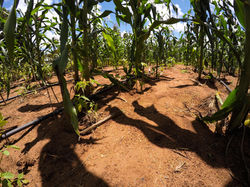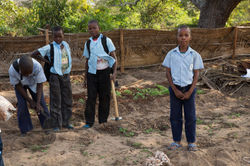
The Agriculture Program
Now that water is available, the wise use in an agricultural context is essential. Using water as a key ingredient in reducing poverty has many possibilities, with small-scale agriculture at the forefront.
Strategic community-wide and household agriculture can lead to food security, health, income, and the stimulation of the local economy in the rural areas.
The Mozambican diet in the rural areas is mainly composed of cassava - a staple with very little nutritional value. It is grown because it doesn't need great soil or much water. Growing other vegetables has not been an option since water wasn't available.
The ability to grow unique crops presents the opportunity to have a better nutrition, food security and the potential to generate income with a more diverse, demand-driven presence in the local marketplace.

Climbing the development ladder with food security and income generation

SEEDS OF CHANGE


Teach it
Concepts of supply and demand, nutritional value in certain crops and wise future investing is discussed in-depth with the Agriculture Division in the Water Oversight Committee.
The garden program is incorporated into the school curriculum under the guidance of the Sustainability and Agriculture Division.
 |  |  |  |
|---|---|---|---|
 |  |

Build it
A 27,000 sq/ft garden is built (by the community members) next to the school and the new water well. All local materials are used and provided by Water Underground, but the construction of the fence, the opening of the land, and preparation are done by the community to re-enforce ownership.
The garden is typically divided in 3 parts (exact specifics are left up to the community to decide).
 |  |  |  |
|---|---|---|---|
 |  |
Main Area
Community Rented Plots
The central portion of the space in the agriculture zone is partitioned into plots available for the community to ‘rent’ for a 4 month (single harvest) period. The fees go into the Committee fund for maintenance & Repair / Sustainability of the overall project. The garden is run similar to a ‘collective’ where they share entry costs for fertilizers/pesticides, seeds, and equipment — alongside the obvious advantage of growing crops directly adjacent to the water well.
Water Underground initiates this program, and supports with 4 months of training of advanced methodologies; but the sustainability of the garden is left to the community.
Some have chosen instead to make it a community garden and share profits while others have left it to the school to manage. Our goal is to simply provide a catalyst to how further development may occur with this new community asset of available water.
The School Plots
One area is reserved for the School Agriculture Program (which we introduce) and has a plot allocated for each grade level. Water Underground leads a training/participatory program for 4 months (a complete harvest cycle), where each grade level is responsible for their own plots. The program is then continued by the teachers after.
Committee Plots for Sustainability
The teachers and committee sometimes use the third area to grow crops that they will take to market - and profits will go directly to the sustainability of the project or development initiatives in the school.


Grow it
Our Agriculture specialists work with the community during one full harvest, from seed to sale.

 |  |  |  |
|---|---|---|---|
 |  |  |  |
We work with methods and materials that are accessible for the community to replicate. most of the community are agrarian by trade, so we try to learn from them and build on that knowledge base. Here are some of the methods we use to improve yields.
Accessible methods

Uniformed organization of crops that will utilize rotation and seperated pesticide/insecticide/fertilizer treatments.

Staking Tomatoes to ensure upright growth to encourage a greater yield. We use these poles every 3 plants, and tie an interweaving cord between them as they grow for support.

The soil in this area is unfortunately very poor, so we teach the community how to create their own compost from cow manure - which they have a lot of!

Uniformed organization of crops that will utilize rotation and seperated pesticide/insecticide/fertilizer treatments.



Harvest it
 |  |  |  |
|---|---|---|---|
 |  |  |


Go to market with it
 |  |  |  |
|---|---|---|---|
 |  |

Drip Irrigation
We install two different kinds of drip irrigation depending on the water system we have installed.
Communities with a manual hand pump use an innovative bucket drip irrigation system we designed; whereas communities with solar pumps use a pressurized system.



We worked to innovate this system of gravity-fed drip irrigation using a simple 20L bucket. By filling up the bucket 1.5 times, a person can irrigate 50m of crops.
Each of these systems costs only $12 USD initial capital investment to build and can yield a net profit of $150 - $200 from each harvest. After implementing new, unique technologies and strategies, it is possible for people to have 3-4 harvests per year while growing demand-focused crops such as tomatoes, beetroot, green beans etc., instead of a rain-dependent single harvest growing profitless cassava.
Simple and low-cost methodologies, such as growing corn in between rows of tomatoes to provide shade, can open up possibilities to household farmers beyond what they ever thought was possible.
This new income stimulates the local economy and can be a rung on the development ladder that they can climb themselves.
This Water Underground drip irrigation model in these gardens is aimed at demonstrating methods and technologies that are accessible and possible for the community to implement in their own homes - not only to benefit the school and sustainability of the water project.
THE WISE USE OF WATER IS IMPORTANT IN AGRICULTURE.
IN THE COMMUNITIES WE WORK IN... IT IS SIMPLY CRUCIAL.


 |  |  |  |  |  |  |  |
|---|---|---|---|---|---|---|---|
 |  |  |  |  |  |  |  |
 |  |  |  |  |  |  |  |
 |  |  |  |  |  |  |  |
 |  |  |  |  |  |  |
Drip irrigation using solar
In communities where we have installed a solar-powered system, we add a 5,000L tank exclusively for agriculture. The garden we build is 30 m x 70 m and outfitted entirely with a professional drip irrigation system. We train the community on how to use it, how to manage it, how to maintain it, and how to profit from it. The typical layout starts with about 650 tomato plants, 300 cabbage, and 300 lettuce plants growing.
This garden can provide a steady source of profit for the community so that they can take their development initiatives anywhere they want. The possibilities are endless, including adding tanks to the overall system, adding distribution lines to nearby houses, adding distribution lines to nearby shops... the only limit is their collective initiative.

With water,
life can grow.
 |  |  |  |  |  |  |  |
|---|---|---|---|---|---|---|---|
 |  |  |  |  |  |  |  |
 |  |  |  |  |  |  |  |
 |  |  |  |  |  |  |  |
 |  |  |  |  |  |  |  |
 |  |  |  |  |  |  |  |
 |  |  |  |  |  |  |  |
 |  |






